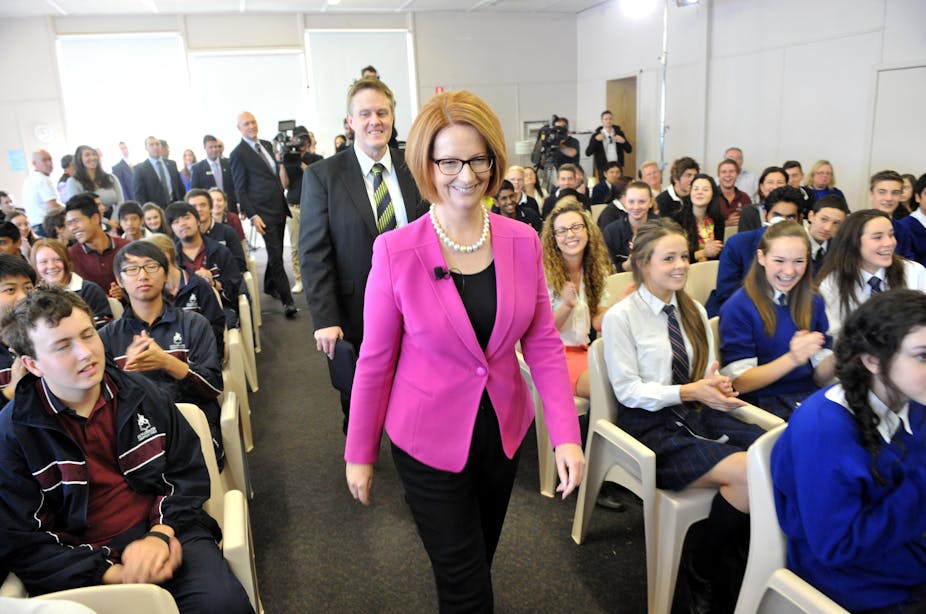Australian heads of government will gather in Canberra tomorrow to deliberate on the Commonwealth’s proposals for school funding reform.
At the Council of Australian Governments (COAG) meeting, the government is offering to put A$9.4 billion on the table, and is asking the states to collectively pay the remaining A$5.1 billion to fund the new system – based on the Gonski review into schools funding.
The Gillard government has already won over one major stakeholder, probably two. From 2014 private non-Catholic schools will enjoy real increases in public funding, amounting to A$1 billion over the next six years. The political spectre of one in four private schools losing out under Gonski has gone.
While it’s still unclear whether Catholic authorities are satisfied with the Prime Minister’s proposal, the contented silence of the independent schools lobby is deafening. On the table is an offer of A$1.4 billion over six years. And all schools will gain in real terms, subject to how funding is moved around within the Catholic systems, a mysterious practice that the original Gonski review endorsed, but wanted made transparent.
But the Gillard government also needs a bigger stakeholder to come on board — the states and territories. There are positive signs from most of the eastern states and from South Australia, offended rejection from Western Australia while Queensland Premier Campbell Newman is equivocal. He would welcome A$2.5 billion from the Commonwealth, but would have to stump up A$1.3 billion from the state’s own coffers which, he claims, are empty.
However, Newman — like the other premiers — knows that he risks a public backlash if he rejects a heavy injection of federal funds into Queensland public schools which — like other state systems — are not free of issues.
The voting public have been told repeatedly that dollars don’t buy quality, but the most well-educated parents continue to stick their nose up at this logic and spend big on private schools. Should the less well-heeled listen to economists and politicians — especially those who increase funding to private schools — or to their social betters?
The situation is different in Western Australia. Here Canberra’s offer is very low — only A$300 million. A third of this must come from the Western Australian government itself. Colin Barnett has been trimming the state education budget over the last few years, and by 2015 will have removed around the same amount of money that the Commonwealth model will put in.
Instead of slashing expenditure, Barnett (and the other premiers) will have to fund 3% growth in real terms each year for the next six years. Rejecting this plan would cost Western Australia not only A$200 million in Gonski federal funds, but a further A$560 million in targeted programs.
The Western Australian Premier has grounds for complaint. His state is already close to the national resourcing standard so on the face of it deserves little. But why is it apparently so advantaged?
Part of the reason lies in the high per-student spending that many remote and very remote schools impose on the public system. This drives up average expenditure. Part, too, is due to favourable pay scales and teacher allowances that enable Western Australia to put teachers into every school, however far away.
Given the national obsession with teacher quality, are we to blame systems that pay their teachers relatively well? Should we penalise them for serving remote indigenous communities?
If the new funding model is to be flexible, not uniform, there should be scope for addressing structural issues, such as remoteness and the small size of schools.
States should not be punished for remunerating teachers highly. The levels of educational disadvantage in Western Australia more than justify a high level of investment in teachers, and it is not the cost of their salaries that government has sought to bring down, but administrative costs.
If, as the Prime Minister requires, teachers in future will be drawn from a much higher academic band, they will also have to be paid more.
The Commonwealth should be creating strong incentives to include all states in the new model. That is what it has been done with the private schools. Every effort was made to “accommodate” all private schools in the model, including the most well-funded.
Surely the same rationale applies to the states?

